Aglaia polyneura is a species of plant in the family Meliaceae. It is found in Indonesia and Papua New Guinea.
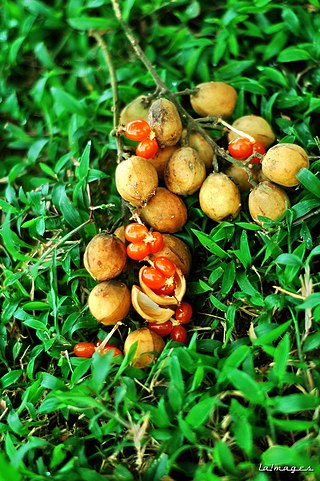
Baccaurea polyneura is a species of plant in the family Phyllanthaceae. It is native to Peninsular Malaysia, and Sumatra island of Indonesia. The fruit, called jentik, is edible, if sour, and is locally harvested and sold.
Buchanania barberi is a species of plant in the family Anacardiaceae. It is endemic to Nadari in Travancore District of Kerala, India. It is threatened by habitat loss.
Myrcia polyneura is a species of plant in the family Myrtaceae. It is endemic to Cuba.
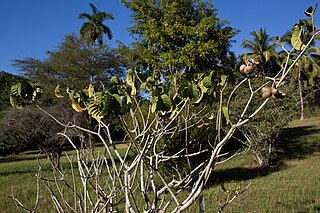
Tabernaemontana apoda is a species of plant in the family Apocynaceae. It is endemic to Cuba. It is threatened by habitat loss.
Tabernaemontana cumata is a species of plant in the family Apocynaceae. It is endemic to the State of Amazonas in northwestern Brazil. The species is listed as endangered.

Tabernaemontana gamblei is a species of plant in the family Apocynaceae. It is endemic to India.

Tabernaemontana alternifolia is a species of plant in the family Apocynaceae. It is endemic to India.
Tabernaemontana muricata is a species of plant in the family Apocynaceae. It is endemic to the state of Amazonas in northwestern Brazil. The species is listed as endangered.
Tabernaemontana remota is a species of plant in the family Apocynaceae. It is found in Sulawesi in Indonesia, and also on Rossel Island, one of the islands in the Louisiade Archipelago, part of the Independent State of Papua New Guinea. The plant is listed as vulnerable.
Tabernaemontana thurstonii is a species of plant in the family Apocynaceae. It is endemic to Fiji.
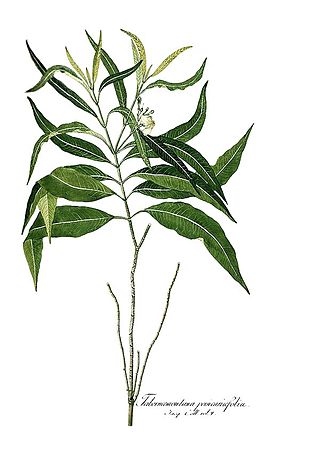
Tabernaemontana persicariifolia is a species of plant in the family Apocynaceae. It is found in Mauritius and Réunion in the Indian Ocean. The species is listed as endangered.
As of July 2016, the International Union for Conservation of Nature (IUCN) lists 238 conservation dependent species. 0.29% of all evaluated species are listed as conservation dependent. The IUCN also lists seven subspecies and five varieties as conservation dependent.

Tabernaemontana divaricata, commonly called pinwheel flower, crape jasmine, East India rosebay, and Nero's crown, is an evergreen shrub or small tree native to South Asia, Southeast Asia and China. In zones where it is not hardy it is grown as a house/glasshouse plant for its attractive flowers and foliage. The stem exudes a milky latex when broken, whence comes the name milk flower

Tabernaemontana crassa is a plant in the dogbane family Apocynaceae, native to tropical Africa.
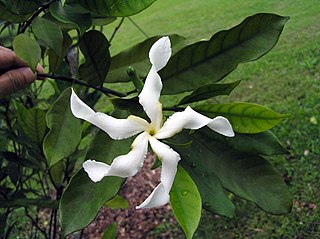
Tabernaemontana macrocarpa grows as a shrub or tree up to 30 metres (100 ft) tall, with a trunk diameter of up to 50 centimetres (20 in). The bark is yellowish brown, brown, grey-brown or grey. Its fragrant flowers feature combinations of cream, white and orange corolla lobes. The fruit is orange, with paired follicles, each up to 16 centimetres (6 in) in diameter. The specific epithet macrocarpa is from the Greek meaning "with large fruit". Its habitat is forests from sea level to 1,500 metres (5,000 ft) altitude. Tabernaemontana macrocarpa has been used as arrow poison. The species is native to Thailand and Malesia.

Tabernaemontana pandacaqui, known as windmill bush and banana bush, is a species of plant in the dogbane family Apocynaceae.
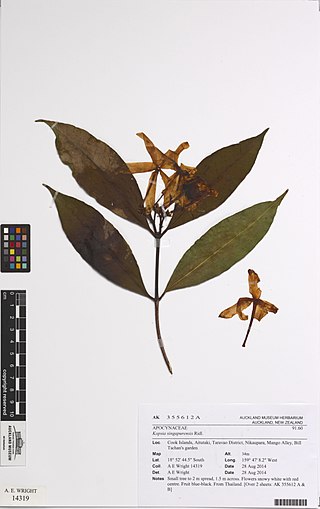
Kopsia singapurensis is a species of plant in the family Apocynaceae. It is native to Peninsular Malaysia and Singapore. It is threatened by habitat loss. It can grow up to five metres tall. When the plant is cut, white latex is produced. The flower has five petals. In Singapore, the tree can only be found in the Nee Soon Swamp Forest. In the wild, it flowers only twice a year, but when cultivated, it is free-flowering if grown under the right conditions.
Micrechites is a genus of flowering plants in the family Apocynaceae, first described as a genus in 1857. It is native to China, the eastern Himalayas, Southeast Asia, Papuasia, and Queensland.
Aframomum letestuanum is a species of plant in the ginger family, Zingiberaceae. It was first described by François Gagnepain.










